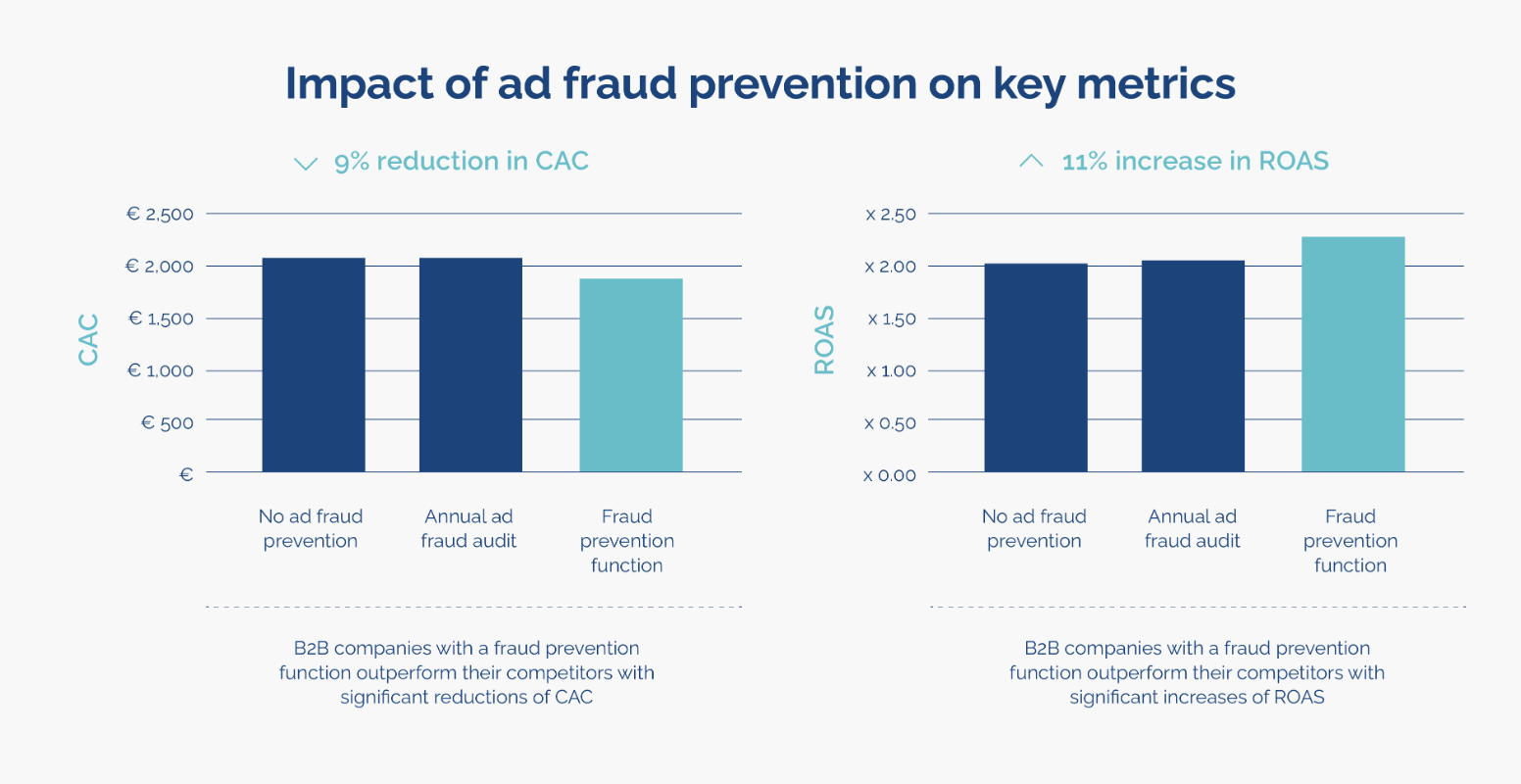Advertisers rely on a wide range of key metrics to measure campaign success, make data-driven decisions, and improve business performance. Ad fraud, however, has a massive impact on KPIs. How big? Our data shows that, on average, without a robust fraud prevention strategy, businesses are likely to suffer from a 9% increase in customer acquisition costs (CAC) and an 11% reduction in return on advertising spend (ROAS).
Here, we demonstrate how ad fraud affects your key metrics and how ad fraud prevention is key to improving several of your most important KPIs.
How ad fraud is affecting advertisers
Wasted ad budgets
The most obvious and direct impact of ad fraud is that it depletes your advertising budget. Since the money you (unwillingly) spend on fraudulent ads won’t lead to any conversions such as actual customers or purchases, you’re virtually burning cash.
Skewed data causes wrong decisions
But it gets worse: ad fraud also creates additional damage indirectly by messing with your campaign data which can cause you to make wrong decisions. For example, you may observe reasonable clickthrough rates (CTR) but very low conversion rates – due to ad fraud – for a specific campaign. As a result, you may decide to shut down this campaign altogether since your (skewed) metrics show it’s not performing. However, in reality, the campaign might actually be quite successful if you removed fraudulent clicks from the equation.
Deteriorated ROAS & CAC
So how does all of this affect your bottom line? Basically, they severely worsen two important metrics: ROAS and CAC.
ROAS measures how much you make on each dollar you spend on advertising campaigns. The higher your ROAS, the better. However, ad fraud techniques such as click fraud, click injections, and click spamming all reduce your ROAS, since you end up paying for illegitimate interactions with your ads.
Similarly, CAC rates — the cost you incur when you acquire new customers — are driven upwards by ad fraud.
Let’s take a look at an example of how ad fraud affects both ROAS and CAC.
A large advertising brand invests $1M a month in advertising and $50k a month into its sales team to convert marketing leads to customers.
- If 11% of their ad spend is wasted on fraud — which we at Opticks have seen to be a common benchmark — this means a loss of €110k every single month and a heavy impact on CAC and ROAS in terms of wasted budgets. Here, a lower ROAS directly leads to a higher CAC.
- If 25% of their leads are fake (i.e. generated by bad bots), around $12.5k is lost each month as a result of the sales team wasting time and resources pursuing unconvertible opportunities created by fraud. This, again, directly causes a higher CAC.
How an ad fraud prevention function improves key metrics
Organizations often develop a lackadaisical attitude toward the attrition caused by ad fraud and even consider the reduction in ROAS and surge in CAC as an unavoidable “cost” of running digital ad campaigns.
However, this should not and does not need to be the norm for advertisers. Instead, by establishing an ad fraud prevention function within your organization, you can proactively stop ad fraud from occurring rather than retroactively repairing the damage it causes.
An ad fraud prevention process, comprising of a fraud committee and fraud prevention systems can help organizations improve key metrics in the following ways:
Ad fraud committee
Ad fraud committees are groups of individuals who oversee the prevention of ad fraud within an organization. They are typically led by the Marketing function, in particular the Director of Paid Media. To keep ROAS high and CAC low, their responsibilities include:
- Reviewing the impact of ad fraud on the organization’s key metrics
- Reviewing ad campaigns to make sure future decisions are based on accurate campaign data, untainted by ad fraud
- Optimizing advertising efforts by investigating new channels and partners
Ad fraud prevention systems
Ad fraud prevention systems consist of an ecosystem of interconnected software solutions that enable an organization to prevent ad fraud. The main pillar of these systems is anti-fraud solutions like Opticks that link and support all other relevant tools together. Other solutions in the ecosystem include CMS, CRM, and analytics tools.
Together, these systems gather important data that is valuable in reducing CAC costs and keeping ROAS rates high by:
- Automatically preventing ad fraud (using an anti-fraud solution like Opticks)
- Providing automatic fraud alerts (using an anti-fraud solution, organizations can receive alerts about possible ad fraud which they can then manually review)
- Investigating fraud (using the data collected to identify any unusual traffic patterns, spikes, and sources)
Data dive: Improvements in key metrics linked to ad fraud prevention functions
Preventing ad fraud isn’t just about protecting campaign budgets, but about maximizing what you can do with them.
Our own data, based on over 466 billion site visits in more than 200 territories during a six-month period, suggests a strong link between having an ad fraud prevention function in place, and better organizational metrics, both for businesses in the B2B and B2C space.
There are three main categories that describe the level of sophistication of an organization’s ad fraud prevention function:
- No ad fraud prevention: Describes organizations with zero ad fraud prevention function in place.
- Annual ad fraud audit: Describes organizations that only complete a one-off review of partners once yearly.
- Fraud prevention: Describes organizations that have a full ad fraud prevention function deployed.
Let’s take a closer look at our findings:
 From our data, it’s clear that having an ad fraud prevention function in place improves ROAS and CAC. In fact, B2B organizations can enjoy an 11% increase in ROAS and a 9% reduction in CAC, helping them outperform their competitors. For B2C organizations, the impact of this function is often even more significant.
From our data, it’s clear that having an ad fraud prevention function in place improves ROAS and CAC. In fact, B2B organizations can enjoy an 11% increase in ROAS and a 9% reduction in CAC, helping them outperform their competitors. For B2C organizations, the impact of this function is often even more significant.
So, not only does an ad fraud prevention function help prevent fraud from damaging campaigns, but it actively helps organizations outstrip their competition.
Ad fraud prevention is key to improving key metrics
As shown, the data clearly demonstrates that the more committed you are to establishing a fraud prevention function within your organization, the better your ad performance will fare.
From this, we can deduce that the combination of ad fraud systems, processes, and committees is not only fundamental to outperforming your competitors, but to improving your key metrics, too.
To find out more about how the expert team at Opticks can provide the ad fraud prevention your organization needs, contact us or start your free trial today.
